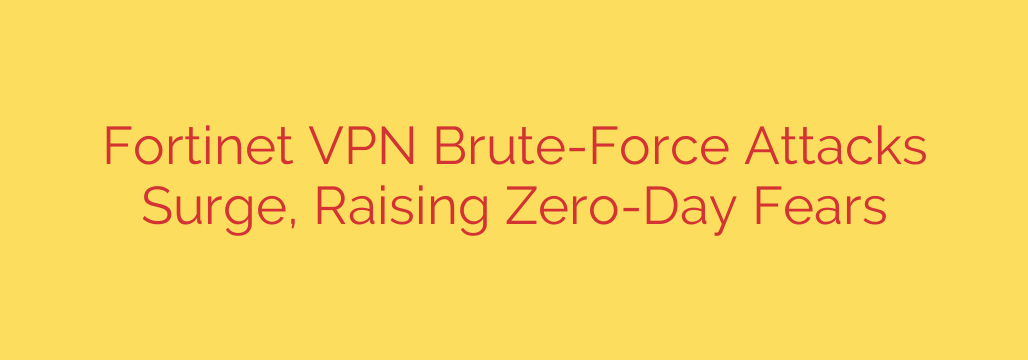
Urgent Security Alert: Fortinet VPNs Under Intense Brute-Force Attack
Cybersecurity experts are tracking a significant and alarming surge in brute-force attacks aimed at Fortinet FortiGate virtual private networks (VPNs). This widespread campaign is targeting government, commercial, and technology sector organizations, indicating a sophisticated and determined effort by threat actors to breach network defenses.
The primary method of attack is brute-force, a technique where automated software systematically tries vast combinations of usernames and passwords until it finds a valid credential. While this method isn’t new, the sheer volume and intensity of the current campaign are raising serious concerns across the security community.
The Goal: Initial Access and a Foothold
The objective of these attacks is clear: to gain initial access to corporate and government networks. Once a successful login is achieved, attackers can establish a persistent foothold, allowing them to escalate privileges, move laterally across the network, deploy ransomware, or exfiltrate sensitive data.
The malicious IP addresses launching these attacks are often associated with a history of suspicious activity, confirming that this is not a random or low-level threat. Instead, it appears to be a coordinated campaign by well-equipped adversaries.
A Troubling Sign: Are Attackers Preparing for a Zero-Day?
While the current attacks rely on guessing credentials, security analysts are worried about a more dangerous possibility. The heightened activity suggests that these attacks could be a precursor to the exploitation of a yet-undisclosed zero-day vulnerability.
A zero-day is a software flaw unknown to the vendor (in this case, Fortinet) and for which no patch exists. Threat actors often conduct reconnaissance before deploying a valuable zero-day exploit. By launching brute-force attacks, they can:
- Identify active and accessible VPN gateways.
- Test the security posture of target organizations.
- Gather intelligence for a more sophisticated future attack.
If attackers can identify vulnerable systems through these initial probes, they can strike quickly and effectively once a new zero-day exploit is developed or acquired. This makes preemptive defensive measures more critical than ever.
How to Protect Your Network Now
Organizations using Fortinet VPNs must take immediate action to harden their defenses and mitigate the risk of a breach. Waiting until a successful login is detected is too late. The following steps are essential for securing your network perimeter.
1. Enforce Multi-Factor Authentication (MFA)
This is the single most effective defense against brute-force attacks. Even if an attacker steals or guesses a valid password, they cannot complete the login without the second authentication factor (like a code from an app or a physical key). If you have not enabled MFA on your VPN, this should be your top priority.
2. Implement Strong Password Policies
Ensure all user accounts are protected with complex passwords that are difficult to guess. Enforce policies requiring a mix of uppercase and lowercase letters, numbers, and symbols. Discourage the reuse of passwords across different services.
3. Actively Monitor and Analyze Logs
Your security team should be closely monitoring VPN logs for signs of brute-force activity. Key indicators include:
- A high volume of failed login attempts from a single IP address.
- Login attempts using a list of common or generic usernames.
- Login attempts originating from unusual geographic locations.
Configure alerts to notify your team immediately when such activity is detected so you can block the offending IP addresses.
4. Keep Your FortiOS Firmware Updated
Fortinet regularly releases patches for known vulnerabilities. Ensure your FortiGate appliances are running the latest version of FortiOS. This won’t stop a true zero-day attack, but it will protect you from being compromised by older, known exploits that attackers often use against unpatched systems.
5. Disable Unused or Dormant Accounts
Review all user accounts with VPN access and immediately disable any that are no longer needed, including those for former employees or temporary contractors. Every active account is a potential entry point for an attacker.
6. Utilize Geofencing and Access Control Lists
If your workforce operates within specific geographic regions, consider using geofencing to block login attempts from all other countries. Additionally, create access control lists (ACLs) to restrict VPN access to only known and trusted IP addresses where feasible.
The current threat landscape demands a proactive, defense-in-depth approach. By implementing these security measures, organizations can significantly reduce their attack surface and protect their critical assets from this aggressive and ongoing campaign.
Source: https://www.bleepingcomputer.com/news/security/spike-in-fortinet-vpn-brute-force-attacks-raises-zero-day-concerns/








